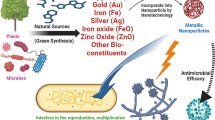Abstract
In recent times, nanotechnology has drawn the attention of the scientific community because of the wide variety of applications that can be done with it, from food packaging to targeted drug delivery; the use of nanoparticles has been a breakthrough in science that has now reached the market. Silver nanoparticles (Ag NPs) have unique properties due to the oscillation of electrons in the superficial plasmon. These nanostructures have been used in different applications in the area of nanomedicine, such as: targeted drug delivery, sensing and imaging, anti-fungal, anti-cancerous and biosensors. It has become evident that pathogenic bacteria are resisting antibiotics such as Penicillin becoming one of the most worrying topics in the world. People in the science community fear the day when we no longer can use these antibiotics, because the resistance of bacteria became too great, leaving us defenceless against any type of pathogens and possibly causing a catastrophe. However, we theorize that the possible solution to this problem could be the use of silver nanoparticles, given that there has not been a documented bacterial adaptation strategy that could give them resistance to Ag NPs. The purpose of this study is to find how the water-stable silver nanoparticles interact with different strains, including Gram negative and Gram-positive bacteria. The main objectives of our research were to synthesize and characterize water stable silver nanoparticles and test their potential bactericidal activity. We synthesized our Ag NPs using sodium citrate as a reducing agent. After synthesizing the nanoparticles, their optical properties were characterized by Ultraviolet-visible spectroscopy (UV-Vis); crystalline structure was evaluated with Electron Diffraction (ED) and X-Ray Diffraction (XRD); morphology was assessed by High Resolution Transmission Electron Microscopy (HR-TEM). Fourier Transform Infra-Red Spectroscopy (FT-IR) was used to indicate functional groups involved in the nanoparticle capping. Cultures were prepared with agarose and inoculated with the following bacterial strains: Bacillus cereus (Gram +), Micrococcus luteus (Gram +), Staphylococcus aureus (Gram +), Escherichia coli (Gram -), Citrobacter freundii (Gram -), Enterobacter aerogenes (Gram -), Klebsiella pneumoniae (Gram -), Proteus mirabilis (Gram -), Proteus vulgaris (Gram -) and Serratia marcescens (Gram -). Preliminary tests showed an inhibition diameter that surpassed 1.0 cm in all bacterial strains. We expect our Ag NPs to have a potential antibacterial activity towards all types of bacteria, due to oxidation of silver (Ag0 to Ag+).
Similar content being viewed by others
References
H. Saber, E. A. Alwaleed, K. Ebnalwaled, A. Sayed, and W. Salem, EJBAS 4(4), 249–255 (2017).
L. Duffy, M. J. Osmond-Mcleod, J. Judy, and T. King, Food Control, 92, 293–300 (2018).
S. Riaz, M. Ashraf, T. Hussain, M.T. Hussain, and A. Younus, Colloids and Surfaces A, 581 (2019).
Y. Zou, Z. Guo, L. Ye, Y. Cui, X. Wang, L. Zhao, and K. Yu, J. Alloys Compd., 803, 527–537 (2019).
A. Becaro, C. M. Jonsson, F. C. Puti, M. C. Siqueira, L. H. Mattoso, D. S. Correa, and M. D. Ferreira, Environmental Nanotechnology, Monitoring & Management, 3, 22–29 (2015).
A. K. Keshari, R. Srivastava, P. Singh, V. B. Yadav, and G. Nath, J-AIM (2018).
M. Shivakumar, G. Krishnamurthy, C. Ravikumar, and A. S. Bhatt, JSAMD, 4(2), 290–298 (2019).
B. Khodashenas, and H. R. Ghorbani, Arab. J. Chem, 12(8), 1823–1838 (2019).
H. Cha, D. Lee, J. H. Yoon, and S. Yoon, J. Colloid Interface Sci., 464, 18–24 (2016).
Y. Mao, P. Ding, Y. Wang, C. Ding, L. Wu, P. Zheng, X. Zhang, X. Li, L. Wang, Z. Sun, Environ Int., 131, (2019).
M. F. Aldayel, J. King Saud Univ. Sci., 31(4), 1227–1234 (2019).
E. A. González, N. Leiva, N. Vejar, M. Sancy, M. Gulppi, M.I. Azócar, G. Gomez, L. Tamayo, X. Zhou, G.E. Thompson. M. A. Páez, J. Mater. Res. Technol., 8(2), 1809–1818 (2019).
N. Durán, M. Durán, M.B. de Jesús, A.B. Seabra, W. J. Fávaro, G. Nakazato, Nanomedicine, 12(3), 789–799 (2016).
M. Behravan, A. H. Panahi, A. Naghizadeh, M. Ziaee, R. Mahdavi, and A. Mirzapour, Int. J. Biol. Macromol., 124, 148–154 (2019).
S. N. Nyamu, L. Ombaka, E. Masika, and M. Nganga, JOIN, 4(3), 86–94 (2019).
G. Suriati, M. Mariatti, and A. Azizan, IJAME, 10, 1920–1927 (2014).
K. Ranoszek-Soliwoda, E. Tomaszewska, E. Socha, P. Krzyczmonik, A. Ignaczak, P. Orlowski, M. Krzyzowska, G. Celichowski, J. Grobelny, J. Nanoparticle Res., 19 (8) (2017).
A. Monshi, M. Foroughi and M. Monshi, WJNSE, 2(3), 154–160 (2012).
B. Lee, M. J. Lee, S. J. Yun, K. Kim, I. H. Choi, and S. Park, Int. J. Nanomed., 14, 4801–4816 (2019).
L. S. de Melo, A. S. Gomes, S. Saska, K. Nigoghossian, Y. Messaddeq, S.J. Ribeiro, and R. E. de Araujo, J. Fluoresc., 22(6), 1633–1638 (2012).
A.M. Jones, S. Garg, D. He, A. N. Pham, and T. D. Waite, Environ. Sci. Technol., 45(4), 1428–1434 (2011).
D. He, C. J. Miller, and T. D. Waite, J. Catal., 317, 198–205 (2014).
D. Wild, The immunoassay handbook, 4th ed. (Elsevier, Amsterdam, 2013), p. 945–962.
Author information
Authors and Affiliations
Corresponding author
Rights and permissions
About this article
Cite this article
Suárez, D.M., Merced Colón, J.A., García-Mercado, W. et al. Potential Bactericidal Activity of Silver Nanoparticles. MRS Advances 5, 975–984 (2020). https://doi.org/10.1557/adv.2020.116
Published:
Issue Date:
DOI: https://doi.org/10.1557/adv.2020.116




